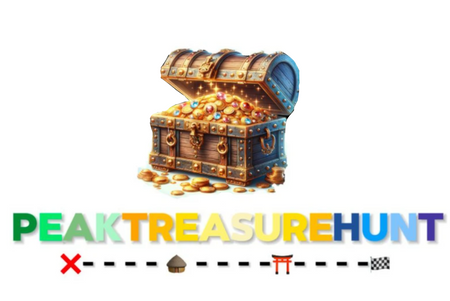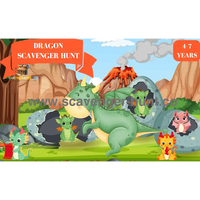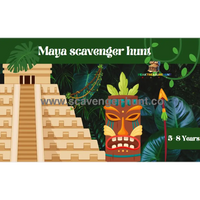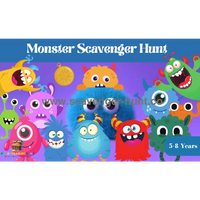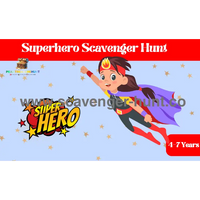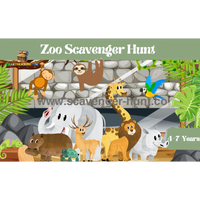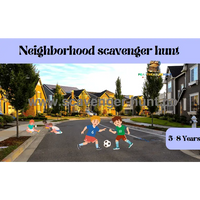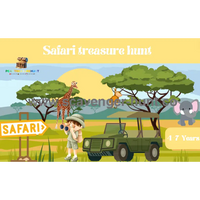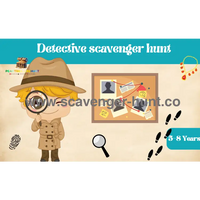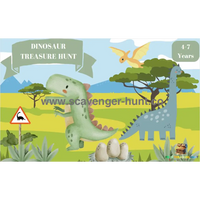Exploring the World of Digital Scavenger Hunts: A Parent's Guide to Modern Adventure
Introduction
In today's tech-savvy world, traditional scavenger hunts have evolved into exciting digital treasure hunts that combine learning with entertainment. These innovative digital exploration games leverage smartphones and tablets to create immersive adventures for children aged 4-12. According to recent studies, 85% of children engage with digital content daily, making digital scavenger hunts an ideal way to channel screen time into productive, educational experiences. This guide will help you understand how to create and implement engaging digital hunts that spark curiosity and promote active learning.
1: Understanding Digital Scavenger Hunt Basics
- What makes a digital hunt different?
- Essential tools and apps
- Safety considerations
- Age-appropriate challenges
Modern digital scavenger hunts use QR codes, GPS coordinates, and mobile apps to create interactive experiences. Popular platforms like Actionbound and Goosechase have seen a 300% increase in educational usage since 2020. Think of these hunts as virtual treasure maps where each digital clue leads to real-world discoveries.
A digital scavenger hunt might sound like something out of a futuristic video game, but it's actually a fun, engaging activity for kids that can be done almost anywhere! 🎮 Instead of searching for physical items like you would in a traditional scavenger hunt, a digital scavenger hunt uses smartphones, tablets, or computers to find virtual clues, complete tasks, or even take photos of certain items. It's like a high-tech treasure hunt! 🏴☠️
How Does it Work?
The basic idea behind a digital scavenger hunt is simple. Kids are given a list of challenges or tasks to complete, and they use an app or a device to find clues, solve puzzles, or explore different locations. Some hunts might ask kids to find information online, like the name of a famous landmark, while others might send them on a photo-taking adventure around their neighborhood or home. 📸 Imagine the excitement when your child is asked to snap a picture of something that starts with the letter "B" — a balloon, a book, or even their beloved pet bunny! 🐰
Why Are They Great for Kids?
One of the biggest reasons digital scavenger hunts are becoming so popular with kids is because they mix learning with fun. Whether your child is finding facts about dinosaurs or solving riddles that lead them to the next clue, they're using critical thinking and problem-solving skills in an exciting way. Plus, with many hunts happening outdoors or involving movement, it gets kids off the couch and exploring their surroundings. 🏃♂️🌳 For parents, it's also a great way to introduce kids to technology responsibly while keeping them active and entertained.
Different Types of Hunts
Not all digital scavenger hunts are the same, and that's part of the fun! Some might be based on themes, like animals, nature, or even a popular movie. Others might focus on educational elements, such as math, reading, or history, which means kids are learning without even realizing it. For example, a hunt might include a clue that asks kids to solve a simple math problem to unlock the next step in their adventure. 🧠💡
Getting Started
There are many apps available that help parents set up digital scavenger hunts easily. Some apps come with pre-made lists of challenges, while others let you create your own custom hunt tailored to your child's interests. If your child loves the outdoors, you could create a hunt that has them searching for specific trees, flowers, or even bugs! 🐞🌼 For those rainy days, a hunt inside the house might involve finding objects of certain colors or shapes. The possibilities are endless, and kids love the feeling of accomplishment when they check off each item from their list. ✅
Safety First!
It’s always important to remember that, even though it’s a game, safety should come first. If the hunt involves going outside, make sure your child knows the boundaries of where they can go and always accompany younger kids. And when using apps or the internet, be sure to review the content to ensure it’s appropriate for your child’s age. 👍
Digital scavenger hunts are more than just games — they’re an adventure waiting to happen. Kids love the challenge, and parents can feel good knowing their children are learning while having fun. Let the hunt begin! 🔍🎉
2: Creating Your First Digital Treasure Hunt
- Selecting the right platform
- Setting up checkpoints
- Designing challenges
- Testing your hunt
Start simple with 5-7 challenges for younger children and up to 15 for older participants. Example calculation: For a 30-minute hunt, plan approximately 3-4 minutes per challenge (30 minutes ÷ 8 challenges = 3.75 minutes per task).
Ready to create your very own digital treasure hunt? 🎉 It might seem a little overwhelming at first, but don’t worry — it’s easier than you think, and so much fun! Here’s a step-by-step guide to help you plan an adventure your kids will love. 💡
Step 1: Choose a Theme
Every good treasure hunt needs a theme to set the tone. Whether it's pirates, superheroes, animals, or space exploration, picking a theme can make the experience way more exciting for the kids. 🦸♂️🦄 For example, if you choose a pirate theme, you could include clues about buried treasure, pirate ships, and islands. 🌴🏴☠️ If your child loves science, a space adventure theme could have them solving mysteries about planets or searching for hidden "alien artifacts."
Step 2: Select the Right Tools
The magic of a digital treasure hunt lies in the tools you use. You’ll need a smartphone, tablet, or computer for your kids to access the hunt. There are plenty of apps that can help you create and run your treasure hunt, like GooseChase or Actionbound, which offer pre-made templates and easy-to-use features for creating your own custom game. 📱💻
If you prefer a DIY approach, you can even create a treasure hunt using simple text clues that your kids follow through the day. Each clue can be sent via message or email, leading them to the next challenge! Some tasks might require them to take pictures, look up fun facts, or even record a short video of their progress. 🎥🤳
Step 3: Write the Clues
This is where your creativity comes in! Write clues that fit your theme and match the difficulty level to your child’s age. For younger kids, keep the clues simple and straightforward. Something like, “Find something in the house that rhymes with ‘cat’” 🐱 (easy answer: hat!) will keep it fun without frustrating them.
For older kids, you can make the challenges a bit trickier. Riddles or puzzles are great for adding a layer of mystery. For example, if you’re running a superhero-themed hunt, you might ask, “What superhero can climb walls and shoot webs?” 🕷️ The answer, of course, is Spider-Man, but they might need to find a picture of him or a related item before moving to the next clue.
Step 4: Mix in Different Activities
To keep things interesting, don’t just stick to written clues — add some fun activities too! Maybe one clue involves solving a puzzle, and the next one asks the kids to take a photo of something that fits the theme, like snapping a picture of their favorite stuffed animal if it’s a jungle-themed hunt. 🐒🐯
You can even throw in challenges that get them moving. For example, “Hop like a bunny to the next clue!” or “Spin around three times before you can move on!” 🐰 These active elements are not only fun but help kids burn off a bit of energy too.
Step 5: Set Rewards or Milestones
Kids love a sense of accomplishment, and what’s a treasure hunt without a reward at the end? 🎁 The prize doesn’t have to be something big. It could be a small toy, a special treat, or even just a certificate celebrating their adventure. You could also include mini-rewards throughout the hunt — maybe after they solve each clue, they get a small prize or badge. 🏅
If your hunt is longer, you might want to set up milestones to keep them motivated. After completing a certain number of tasks, they could unlock a bigger hint for the final prize or get a break to recharge with a snack. 🍎🍪
Step 6: Play Together
While it’s fun to let kids explore on their own, sometimes the best part of a digital treasure hunt is doing it together! 👨👩👧👦 You can play the role of the game master, giving hints when needed or joining in on the adventure yourself. Not only does it make the experience more interactive, but it also gives you a chance to spend some quality time with your kids, creating memories that last long after the game is over.
Step 7: Review and Refine
Once your first hunt is done, take some time to review what worked and what didn’t. Were the clues too hard or too easy? Did they enjoy the activities? This feedback will help you refine your next digital treasure hunt and make it even more awesome! 🌟
By following these simple steps, you can create an unforgettable digital treasure hunt that’ll keep your kids entertained, learning, and having fun. So go ahead — start planning, and let the adventure begin! 🔍✨
3: Educational Benefits of Digital Exploration Games
- Problem-solving skills
- Digital literacy
- Physical activity
- Social interaction
Research shows that children who participate in digital scavenger hunts demonstrate a 40% improvement in critical thinking skills over six months.
Digital exploration games might seem like pure fun and entertainment, but they offer incredible educational benefits for children. These games combine the thrill of discovery with learning, allowing kids to engage their minds while having a blast. 🌟 Whether it’s a treasure hunt, a puzzle-solving adventure, or a game where kids explore virtual worlds, these activities can have a profound impact on their development. Let’s dive into the benefits! 🎮🔍
1. Encourages Critical Thinking and Problem-Solving
One of the biggest advantages of digital exploration games is how they push kids to think critically. 💡 These games often involve puzzles, riddles, or challenges that require children to analyze situations and come up with creative solutions. Whether it’s figuring out how to navigate a maze or solve a tricky riddle to unlock the next clue, kids are constantly exercising their brains. 🧠
For example, in a digital scavenger hunt, a child might be asked to find three objects that start with the letter “S.” While it seems simple, they have to think through their surroundings, categorize items in their mind, and make decisions quickly. These are valuable skills that apply to problem-solving in everyday life. 🏆
2. Enhances Research and Technology Skills
Since many of these games require kids to look up information, find clues online, or use apps, they naturally improve their research and tech skills. 🌐 In today’s world, where technology is everywhere, learning to navigate digital tools early is an essential skill for kids. Digital exploration games teach them how to search for answers, use apps effectively, and even practice their typing skills. ⌨️
For example, in a game where they need to search for information about famous historical landmarks, they’ll learn how to use search engines, sift through data, and find the most relevant facts. This process encourages independence in learning and builds confidence in using digital resources. 💻📖
3. Boosts Creativity and Imagination
When kids play exploration games, their creativity gets a major boost. 🎨 Whether they’re creating stories around the characters in a game or imagining themselves as a pirate searching for treasure, these activities inspire kids to think outside the box. 🏴☠️
In some digital treasure hunts, kids might be asked to come up with their own clues or take photos of things they imagine as part of their adventure. This kind of open-ended play allows them to explore their imagination and invent new worlds. 🚀 It’s a great way to build storytelling skills and encourage a love for creative expression.
4. Encourages Teamwork and Social Skills
Many digital exploration games can be played with friends or family, making them perfect for encouraging teamwork and building social skills. 👨👩👧👦 Whether kids are working together to solve a series of clues or competing to see who can finish the hunt first, they learn how to collaborate, communicate, and work as a team.
For example, if a group of children is playing a game where they need to find items around their home, they’ll have to coordinate, divide tasks, and share ideas. 🗣️👫 This builds essential life skills like cooperation, leadership, and active listening, which are just as important as academic skills. Plus, it’s a great way for kids to bond and have fun together!
5. Enhances Memory and Focus
Digital exploration games also help improve memory and focus. 🧩 Kids often need to remember sequences, follow detailed instructions, or recall past clues to progress in the game. This constant mental exercise strengthens their memory over time. 📝
For example, in a treasure hunt, kids might need to remember where they found a clue or the specific details of a previous challenge. The focus required to keep track of everything and avoid getting sidetracked helps improve their attention span — a valuable skill both in and out of school. 📚
6. Physical Activity (with the Right Game)
Some digital exploration games get kids moving, which is fantastic for their health. 🏃♀️🌳 Apps like Pokémon Go or digital treasure hunts that require outdoor exploration encourage physical activity as part of the fun. Kids might need to walk around their neighborhood, visit local parks, or just run around their backyard as part of the game. This mix of mental and physical activity keeps them engaged while helping them stay active. 🚴♂️
In a time where many kids spend hours indoors on screens, digital exploration games can be a perfect blend of learning and physical exercise. 🌟 Balancing mental challenges with physical movement can lead to healthier habits and a happier child.
In Summary
Digital exploration games are much more than just playtime — they offer a wealth of educational benefits that help children grow mentally, socially, and physically. Whether it’s improving their problem-solving skills, boosting creativity, or encouraging teamwork, these games have a lot to offer. And the best part? Kids don’t even realize they’re learning because they’re too busy having fun! 🎉 So go ahead, let your little explorers dive into the digital world and watch them thrive. 🌍🚀


4: Advanced Digital Hunt Techniques
- Incorporating augmented reality
- Multi-location challenges
- Team-based competitions
- Progressive difficulty levels
Once you’ve mastered the basics of digital scavenger hunts, it’s time to take things up a notch with some advanced techniques. These tips will make your hunts more challenging, interactive, and engaging for kids who are ready for the next level! 🚀 Let’s explore how you can enhance your digital treasure hunts and turn them into epic adventures. 🎉
1. Use Augmented Reality (AR)
If you really want to wow the kids, integrating augmented reality (AR) into your digital hunt is a game-changer. AR blends the real world with virtual elements, making it feel like the clues or treasures are right there in front of them. 🕶️ Apps like Pokémon Go have already shown how fun this technology can be for kids, and you can bring that magic to your hunts too!
For example, you can use an AR app to create clues that only appear when the player points their phone at certain objects or locations. Imagine the excitement when your child points the camera at the backyard tree and a virtual treasure chest appears! 🌳💎 This adds a whole new level of immersion to the hunt and makes it feel like the adventure is coming to life.
2. Incorporate Puzzles and Codes
For older kids or those who love a good brain teaser, adding puzzles and codes can make the hunt more complex and rewarding. 🧩 Instead of just giving direct clues, you can hide your hints in a secret code, like a Caesar cipher (a type of code where each letter is shifted by a certain number). Kids will have to crack the code to reveal the next step! 🕵️♂️
Here’s an example: Instead of saying, “Look in the kitchen,” you can encode it as “Pssz gtqf kbnuyw.” The kids will have to figure out how to decode the message to know where to go next. You can also mix in math puzzles, crosswords, or logic problems to keep them engaged and thinking critically. 🧠 It’s a fun way to challenge their problem-solving skills while keeping the hunt interactive.
3. Time-Based Challenges
Adding a time limit to certain parts of the hunt can make it more exciting and intense! ⏳ Set up a challenge where kids have to complete a task or find a clue within a specific amount of time. For instance, they could have five minutes to find three objects in the house that start with the letter “T.” If they succeed, they unlock the next clue. If they don’t, they might have to complete an extra task to make up for it! 🏃♀️
You could also create race-against-the-clock missions where kids compete against each other or work as a team to finish before time runs out. This adds an element of excitement and can lead to lots of giggles and friendly competition. Plus, it helps kids develop quick thinking and the ability to focus under pressure! 🔥
4. Multi-Location Hunts
For an epic adventure, take the hunt beyond the house and create a multi-location scavenger hunt. 🏙️ This type of hunt works great if you’re in a safe, familiar area like a park, your neighborhood, or even a nearby shopping mall. You can place different clues in various locations, like at a playground, a friend’s house, or a local café. Each location will lead them closer to the final prize! 🌟
You can even use GPS-based apps like Geocaching, where players search for hidden items using real-world coordinates. 🌍 The combination of using digital tools and real-world exploration makes for an unforgettable hunt. Just make sure to set clear boundaries for where they can go and ensure safety if the hunt involves traveling across different spots.
5. Create a Storyline
What’s better than a scavenger hunt? A scavenger hunt with an epic storyline! 🌟 Instead of just random clues, weave a story into the adventure that guides the kids through the game. For example, they could be secret agents on a mission to recover stolen treasure, or explorers trying to solve an ancient mystery. 🕵️♀️🔎
Each clue could be a part of the story, with new characters, plot twists, or obstacles they need to overcome. You could even record videos of yourself (or other family members) playing different roles, like a pirate captain giving them their next mission, or a scientist asking for their help to save the world. 🦸♂️📜 This makes the game more engaging, as kids become invested in the story and are excited to see what happens next!
6. Interactive Clues and Tasks
One advanced technique to make the hunt more engaging is to introduce interactive tasks that involve using technology or completing creative challenges. For instance, you could ask kids to record themselves singing a song, doing a silly dance, or reciting a funny poem before they can move to the next clue. 🎤💃
You can also integrate video clues where the kids watch a short clip that gives them hints or sends them on their next mission. Or have them Facetime a “mysterious” character (like a grandparent or a family friend) who gives them a clue in real-time. These kinds of tasks make the hunt feel more dynamic and personalized, adding an extra layer of fun.
In Summary
With these advanced digital hunt techniques, you can take your scavenger hunts to the next level! From augmented reality and secret codes to time-based challenges and epic storylines, there are endless ways to make the adventure more thrilling and memorable for kids. 🎮🎉 So whether you’re planning a weekend activity or looking for a way to entertain a group of friends, these tips will help you create a hunt that’s both fun and educational. Let the adventure continue! 🔍✨
5: Keeping Digital Scavenger Hunts Safe and Fun
- Setting boundaries
- Monitoring progress
- Adapting difficulty
- Celebrating success
Digital scavenger hunts are an amazing way for kids to learn and have fun, but as with any activity that involves technology and exploration, it’s important to make sure they’re both safe and enjoyable. 🎯 By taking a few precautions, you can create a fun environment where kids can explore freely while staying protected. Let’s go over some tips to keep everything running smoothly! 👍
1. Set Clear Boundaries
Before the hunt begins, it’s important to set clear boundaries for where kids can and can’t go. 🚧 If you’re doing the hunt indoors, make sure they know which rooms are off-limits. If the hunt involves going outside, establish safe zones like the backyard, a nearby park, or specific streets they can explore. 🏡🌳
For older kids participating in a more extensive outdoor hunt, you can create virtual geo-fences using apps that allow you to track their location in real-time. This helps ensure they don’t stray too far and lets you monitor their safety. Always make sure younger kids are accompanied by an adult if the hunt involves moving to different locations.
2. Supervise Screen Time
While digital scavenger hunts use technology, it’s still important to monitor screen time. 👀 Too much time spent staring at a device can lead to fatigue or, in the case of outdoor hunts, distraction from their surroundings. Balance is key! Make sure there are plenty of non-screen-related activities during the hunt, like running to find items or completing physical tasks (like hopping, dancing, or playing pretend). 🏃♀️🎶
If kids are using apps or the internet for their hunt, set up parental controls to limit their access to specific websites or content. 🔒 You can also guide them in using apps responsibly, reminding them to take breaks, stay aware of their surroundings, and not to get too caught up in the screen.
3. Choose Kid-Friendly Apps
When planning your hunt, be sure to select kid-friendly apps and tools. There are lots of options out there, but not all are designed with children’s safety in mind. Apps like GooseChase, Actionbound, or Seek by iNaturalist are great choices that are safe, easy to use, and designed for interactive learning. 📱
Look for apps with no ads or limited in-app purchases to avoid accidental charges or exposure to inappropriate content. It’s always a good idea to test out the app yourself first to ensure it’s suitable for your child’s age and interests.
4. Keep Personal Information Private
One of the most important safety tips when using digital tools is to remind kids not to share personal information online. 🛑 If the scavenger hunt involves posting photos or videos online, make sure the platform is private or only accessible to friends and family. Teach kids to avoid sharing personal details like their full name, address, or school.
If the app or game involves interacting with others (like multiplayer games or live competitions), make sure to supervise those interactions. It’s always best to keep the game within a small, trusted group, like family members or close friends, to avoid any unnecessary risks. 👨👩👧👦
5. Stay Aware of the Environment
If your digital scavenger hunt is taking place outdoors, make sure the kids stay aware of their environment. 🌍 While it's fun to get caught up in the excitement of finding clues or completing tasks, it’s important that they keep their eyes on where they’re going. Remind them to look both ways before crossing streets, avoid dangerous areas, and be mindful of uneven surfaces or obstacles. 🚶♂️🚧
For younger kids, it's best to have an adult or older sibling accompany them during outdoor hunts, especially if the hunt takes them through busy areas. For everyone’s safety, ensure that no one is walking while staring at their screens. Instead, encourage kids to stop, check their clues, and then move to the next location. 🚦
6. Balance Fun and Challenge
While it’s exciting to push the limits with advanced hunts and challenging puzzles, it’s important to balance fun and difficulty. 🧩 Make sure the tasks aren’t too hard for the child’s age, or they might get frustrated. On the other hand, if the clues are too easy, they might lose interest quickly. The goal is to keep things engaging without overwhelming them. 🎉
One good strategy is to mix in a few easy tasks for a quick win and sprinkle in a couple of more challenging puzzles to keep things interesting. You could also add silly or creative tasks like "Take a selfie with your favorite stuffed animal" 🧸 or "Dance like a robot for 10 seconds" 🤖 to keep them laughing and enjoying the game.
7. Involve the Whole Family
One way to ensure safety and maximize the fun is by involving the whole family. 👨👩👧👦 Parents, siblings, and even grandparents can take part in the hunt as team members, clue creators, or judges for the creative tasks. Not only does this make it safer by having more eyes on the kids, but it also turns the event into a fun, shared family activity.
You can create a mini competition where teams race to complete their hunts or work together to solve the most challenging puzzles. This teamwork encourages family bonding and makes the experience more memorable. 🎉❤️
In Summary
By keeping safety top of mind, you can make sure your digital scavenger hunts remain fun and worry-free. Whether it’s setting boundaries, choosing the right apps, or balancing screen time with physical activity, these small steps can make a big difference. 🌟 With a bit of planning and the right precautions, kids can enjoy an exciting, interactive adventure while staying safe and engaged. Let the (safe) fun begin! 🔍✨
Frequently Asked Questions
Q: What age is best for starting digital scavenger hunts?
A: Children as young as 4 can participate with parent supervision, but 7-12 is the ideal age range for independent engagement.
Q: How long should a digital scavenger hunt last?
A: For younger children (4-7), aim for 20-30 minutes. Older children (8-12) can enjoy hunts lasting 45-60 minutes.
Q: What devices do we need?
A: Most hunts require a smartphone or tablet with internet access and a camera. Some advanced hunts might need GPS capabilities.
Q: Are digital scavenger hunts safe?
A: Yes, when properly supervised and using child-safe apps. Always review privacy settings and set clear boundaries.
Q: How much should digital scavenger hunts cost?
A: Many apps offer free basic versions. Premium features typically cost $5-15 monthly. You can also create custom hunts for free using basic tools.
Conclusion
Digital scavenger hunts represent the perfect blend of technology and traditional outdoor adventure. By incorporating these modern treasure hunts into your child's routine, you're not just providing entertainment – you're fostering crucial 21st-century skills. As technology continues to evolve, these interactive experiences will become increasingly valuable tools for learning and development. Start small, be creative, and watch as your children discover the joy of digital exploration while building essential life skills.
Discover our Complete Scavenger Hunts Collection.
